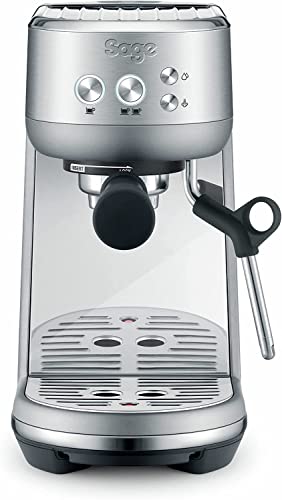9 . What Your Parents Teach You About Machine Espresso
페이지 정보

본문
 How Does Machine espresso machine with milk frother Work?
How Does Machine espresso machine with milk frother Work?Machine espresso uses precision pressure and mind-blowing filter technology to make the delicious coffee we enjoy. How does it work exactly?
To make an espresso, hot water is pushed under pressure through finely ground coffee. The process is similar to making drip coffee, but the major difference is in the pressure.
The Group Head
The name implies the group head is where you put your portafilter in when making espresso. It disperses water in the portafilter, and then regulates the pressure of the extraction. There are numerous kinds of group heads each with its own advantages and drawbacks. Some are focused on temperature stability, some on pre-infusion capabilities, while others are designed to control the lever. There are even some that contain a variety of features, like the E61 one, which is the classic choice among many baristas because of its ability to provide multiple benefits in one package.
As you can see in the image above the group head comes with many notches in which you can place your portafilter and then twist it manually to secure it. There is also a gasket of rubber in the notches to help create a seal when you insert your portafilter into the machine. The notches on the head permit a precise position of the portafilter which is necessary for an efficient extraction.
Aside from allowing you to easily insert your portafilter, the group head is responsible to ensure that the temperature remains even. It does this by circulating hot water through the brew basket, and around the portafilter to ensure that it is always at the right temperature for extraction. This is crucial, since even a small difference in temperature can be the difference between a good and excellent espresso.
The Pump
In contrast to manual piston machines which use a lever to pressurize water, the rotary espresso machines use motorized pumps to deliver the nine atmospheric bars of pressure needed for espresso extraction. This pressure is generated by pumping water through a heat exchanger and then through the ground coffee.
Pumps are typically less expensive and last longer than piston-driven machines. However, both types of machines are susceptible to degrading due to overuse and poor cleaning. Pumps are also more complex mechanically, which can increase the cost of even simple models.
Some espresso machines use steam pressure instead of a pump for brewing espresso. The downside is that the boiler that produces steam also raises the temperature of the water until it reaches boiling which can cause over-extraction. These machines also have to constantly rebuild their pressure in between cups. This takes energy and time.
A majority of espresso machines use the rotary or vibration pump, which has a vibration model using a vibrating disc to create the pressure, and an rotary model that pushes hot water through the grounds at high speed. Both types of machines can make a great espresso, however Rotary machines are quieter and more durable than vibration pumps.
The Boiler
The boiler is the component that heats water to an ideal temperature for extraction. The steam that is produced reaches the portafilter containing the ground espresso and is then pumped down into the cup. The steam causes pressure to push through the coffee grounds. This creates a foam on the top of the espresso. This is one of the main characteristics of a good espresso.
There are three distinct types of espresso machines, each having distinct pumps and brew temperature. There are also different ways that the brew can be controlled, as well as the size of the cup the maker can create.
The earliest espresso machines were steam-based. The earliest espresso machines were steam-type machines. The coffee tasted bitter and burned. The modern espresso machine was designed by the Milanese manufacturers Luigi Bezzerra & Desiderio Pavoni.
The most common espresso maker is a semiautomatic machine with an electric pump. When people think of espresso machines, they imagine these machines. With a semi-automatic espresso machine, you grind the beans and tamp them by hand, but the pump controls the flow of water and pressure. This is a great combination of human control and mechanised reliability.
The Filter
Espresso machines typically have a filter that separates the grounds of coffee from hot water. The filter is also an essential component of the machine's temperature control, since it helps to prevent overheating.
It also helps with flavor, as it lets you enjoy a longer bloom time. This allows the beans to let their nuances out, Machine Espresso and allows for better extraction.
It is important to keep in mind that even the most efficient filter can produce a bad cup of coffee. The quality of the beans and the extraction process remain crucial.
It's in this area that the magic occurs. This is the reason why espresso tastes so delicious. The grouphead (also called the brewhead) is where you put the portafilter, the device which you put the coffee grounds into, when making espresso.
Steam-driven espresso machines make use of hot water that is heated in an airtight container to make steam. The steam then moves hot water through the grounds of the coffee under pressure. These machines are less expensive and are easier for the user to maintain than pumps-driven models. They are however limited in their ability to create the ideal brewing conditions as they only operate with 1-1.5 bar of pressure. The perfect shot requires 9-10 bars.
In recent years, compressed air-driven espresso machines have been gaining popularity. They utilize an air compressor to force hot water through the ground and are much more mobile than steam-driven electric espresso machines.

- 이전글All-Inclusive Guide To Avon Perfumes Uk 24.05.01
- 다음글Zovirax i lirë në internet Blej Zovirax Gjenerik Pa Recetë 24.05.01
댓글목록
등록된 댓글이 없습니다.

